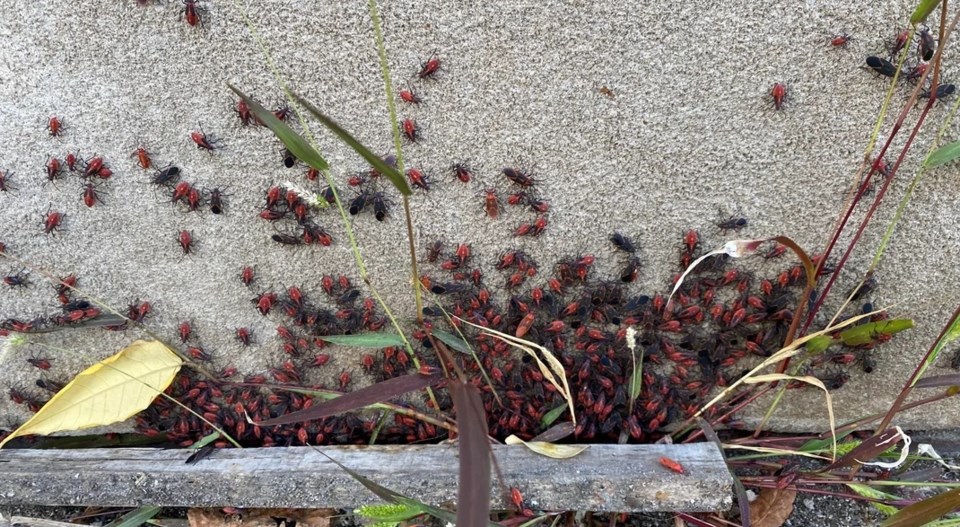Unwanted house guests come in all shapes and sizes. Some, like mice, demand immediate attention due to their potential to spread disease. Others, however, are more on the harmless side of the spectrum.
With its distinctive red and black markings and a flat physique, we're referring to the relatively harmless boxelder bug, that is currently making its presence known across parts of Ontario.
Here's the good news: boxelders won't give you a painful bite or sting, and they certainly won't become disease carriers. Unlike certain ants or termites that can wreak havoc on your home, these bugs won't nibble away at your precious belongings or attack your beloved plants.
what is this bug and is it invasive to ontario canada?
byu/grindylin inwhatisthisbug
But before you start applauding their harmlessness, there's a catch – they can be a bit of a nuisance. These social bugs have a penchant for congregating near windows and doors, forming clusters that could leave behind unsightly stains.
So, let's dive into the world of boxelder bugs and discover the best ways to deal with their uninvited presence.
Named after their beloved host, the boxelder tree, boxelder bugs, or Boisea trivittata, belong to the "scentless plant bug" family, according to Environmental Pest Control. During warm months, they make their homes on boxelder, ash, and maple trees, feasting on seeds, twigs, and leaves. Spring is the season for breeding, and they even dabble in fruits like peaches, plums, and cherries during dry summers. Their populations fluctuate significantly by location and year.
Any idea who this guy is? Found a bunch in southern Ontario
byu/-2008hondacivic- inwhatisthisbug
Adult boxelder bugs sport a distinctive appearance. They measure 11 to 14 mm in length, with a flattened, elongated red and black body. These bugs can have up to three generations per year, depending on their habitat. With a lifespan of approximately one year, they emerge from hibernation in late April to early May, seeking refuge in boxelder trees.
In their natural habitat, these bugs can harm host plants by distorting leaves, damaging flowers, twigs, and seeds. Inside homes, they're a different story. Large infestations can lead to an unsightly mess, as they leave reddish-orange stains when crushed. Their droppings can also mar surfaces. Worse yet, their presence might attract carpet beetles, which can further damage stored items.
So, why do these bugs invade homes? Blame it on a mix of late August warmth and the bugs' attraction to south-facing surfaces on trees, rocks, and buildings. As the temperature drops, they seek shelter to overwinter, slipping into your home through tiny cracks and crevices in walls, doors, windows, and eaves.
Throughout spring and summer, boxelder bugs thrive outdoors but come fall, they look for shelter among bark crevices, leaves, and debris. As the weather gets cooler, they infiltrate buildings through any available openings. Inside, they hibernate, remaining dormant without reproducing or feeding. In spring, they awaken, often surprising homeowners with their sheer numbers.
How to Get Rid of Boxelder Bugs
Prevention in both fall and spring is the best approach for getting rid of these bugs. Pest proofing your home or building helps to minimize the chances and number of insects that gain entry. Here are some things that you can do to help prevent a boxelder bug infestation:
- Repair holes in damaged window and door screens.
- Install or repair screens in roof and soffit vents.
- Install door sweeps on exterior doors.
- Use a good quality silicone or silicone-latex caulk to seal exterior cracks, crevices, gaps and holes around:
- Windows, doors, siding, eaves and fascia boards.
- Roof joints and behind chimneys.
- Places where utility pipes, plumbing, wires or cables enter the building.
To remove them, you can also sweep them up with a broom and dustpan and toss them outside, suck them up with a vacuum or grab them in a tissue and flushed down the toilet.
Whatever you do, avoid squashing them, as their red guts are stinky and can leave permanent stains. They can also emit the stink when they're under stress.




